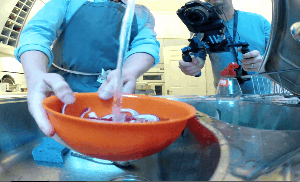Measure Training Effectiveness Restaurants
Each year globally many millions in Sterling are spent on training in the Hospotality Industry. It would seem reasonable to establish just how effective this training has been if only to help justify the budget.
When it comes to evaluating training effectiveness, the Psychological Community typically falls into two main camps. The narrow focused approach being attributed to Donald L Kirkpatrick in the early 1960s and the somewhat broader model advocated by P. Warr et al (The Evaluation of Management Training) known as the CIRO model. The CIRO model looked at context evaluation, input evaluation, reaction evaluation and outcome evaluation. Personally I have found Kirkpatrick's methods to be the most widely adopted in the Hospotality Industry.
Donald L Kirkpatrick’s "Four steps to measuring training effectiveness”
This model uses four separate stages for the evaluation of the effectiveness of a training program.
The four stages are:-
- Reaction – How the trainee “feels about the course”?
- Learning – Did learning occur?
- Behavior – Has behavior changed?
- Results – Has productivity or quality of work improved?
1. Reaction - We use post course feedback to attain this.
The first stage is about the reaction of the trainee to the training. This sort of measurement is concerned with how the trainees "feel” about the course. The usual course feedback sheets are an example of the Kirkpatrick level 1 evaluation. Most organisations do not do any more than this type of measurement and analysis. The drawback is that we do not really know if the trainee has actually learnt anything.
2. Learning - We use pre & post-tests than compare the results to validate this.
The second stage is about answering the question, did learning occur? We can test this by using a pre-test and post-test and comparing the results. The questions need to be objective and closely related to the course objectives. In this way we can determine if the training actually delivered knowledge and this was understood by the trainees at the time. Weather or not the trainee remembers the training 3 weeks later is answered in the next stage.
3. Behaviour - We use trainer/ manager feedback to validate this.
The third stage is about measuring if behaviour has changed. By that we mean the measurable change in an individual as a result of their attendance on the training course. While a behaviour may change during a training session, or even for a few days immediately after that, it is critical to revisit the trainee with a post training assessment at least 1 week after the training has occurred. In the Hospotality Industry this could mean a visit by a district manager or a feedback form completed by a direct supervisor. A sustained change in behaviour must me observed.
4. Results - We look to improvement in our KPI’s to validate this.
The fourth and final stage is about looking to our KPI's to determine if the training was ultimately successful. We need to look at our KPI's to determine if the training has actually been translated into tangible benefits to the organisation. These are metrics which really have an impact on the "bottom line” and for that reason feature in the companies balance sheets and KPIs.
We have to ask ourselves is this not the real reason for training?
Training has to make a real difference in performance and effectiveness. Training has to deliver measurable results. If you are running training programs at your restaurant organization, and you, like most companies are not measuring effectiveness... you may have one or more of the following problems:
High-turnover of staff, low morale, consistency issues, cleanliness issues, performance issues, quality issues.
If this is the case, reach out to us, let us help you.













